Mushrooms are fascinating organisms, offering a vast array of flavors, textures, and appearances. Among the many types of mushrooms, those mushrooms that grow under spruce trees hold a special allure for foragers and nature enthusiasts alike.
Let discover the diverse world of mushrooms thriving in the shade of spruce trees, providing valuable insights into their identification and characteristics.
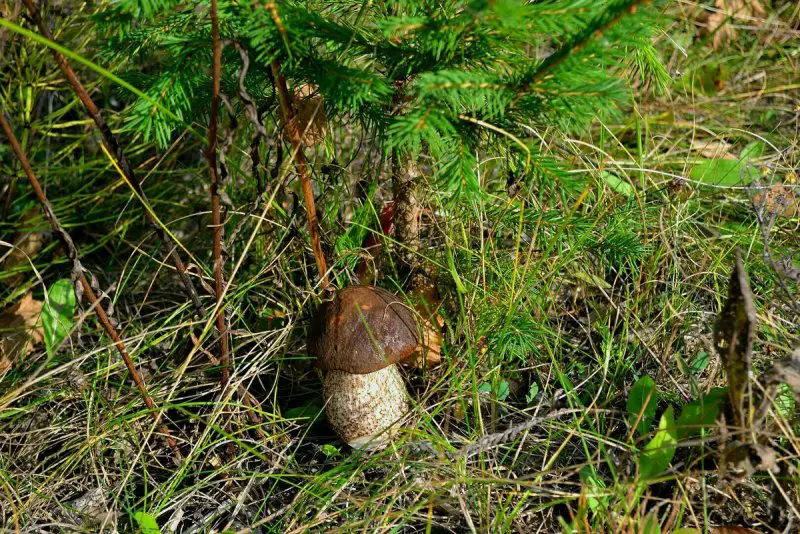
Mushrooms That Grow Under Spruce Trees
Table of Contents
Mushrooms That Grow Under Spruce Trees
Exploring the diverse world of Mushrooms that grow under spruce trees reveals a rich tapestry of colors, shapes, and flavors.
List of Varieties of Mushrooms Grow Under Spruce Trees:
- Lactarius salmonicolor
- Russula amethystina
- Russula sardonia
- Russula delica
- Russula mustelina (Weasel Russula)
- Russula fellea
- Russula Purple Brittlegill
- Russula xerampelina
- Lactarius lignyotus
- Lactarius trivialis
- Lactarius scrobiculatus
- Lactarius mellow
- Lactarius repraesentaneus
Mushrooms that grow on under birch Trees with names and pictures.
Lactarius salmonicolor
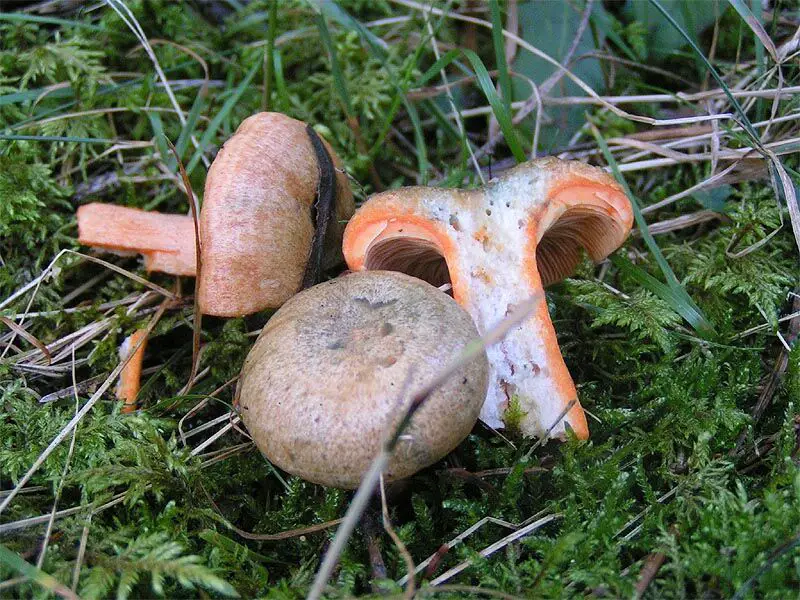
Lactarius salmonicolor, commonly known as the orange mushroom, captivates with its vibrant hues and intriguing characteristics.
Characteristics:
- Cap: Convex, transitioning to flat-concave with age, adorned with darker concentric zones.
- Plates: Descending, quickly turning green when pressed.
- Spores: Light buff, elliptical, ornamented.
- Leg: Cylindrical, brittle, matching the cap’s coloration.
- Pulp: Initially orange, turning red then green, with a fruity aroma.
- Milky Juice: Abundant, non-caustic, undergoing a color change from orange-red to green.
Habitat & Season:
Found in spruce forests, flourishing on needle-covered floors, primarily in summer and autumn.
Culinary Usage:
Despite foreign literature describing it as bitter, in Russia, it’s deemed edible. Often used fresh, salted, or pickled, though it turns green in preparations.
Season: summer – autumn.
Similar species:
- Pink volnushka (lat. Lactarius torminosus), but differs from it in the orange color of the plates and abundant orange juice.
- Real camelina (lat. Lactarius deliciosus), from which it differs in its place of growth and smaller size.
Russula amethystina
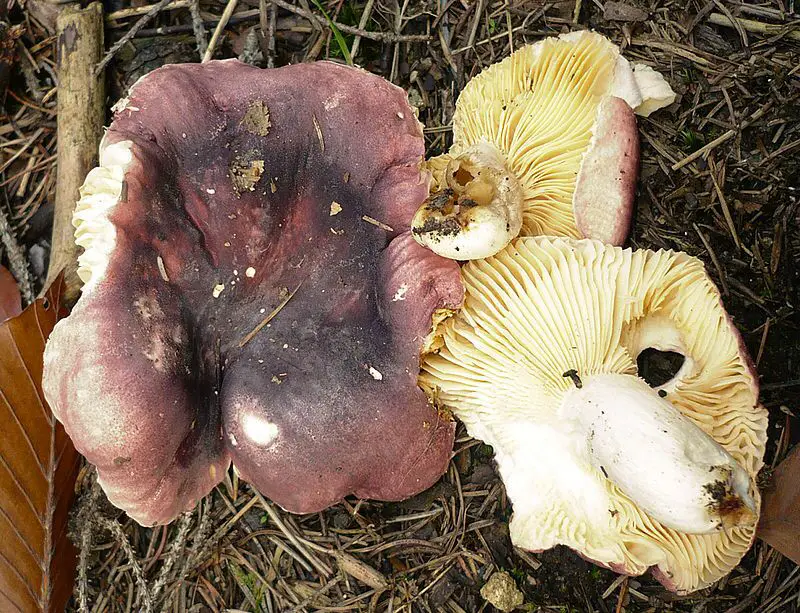
Russula amethystina, a captivating member of the fungi kingdom, boasts delicate features and intriguing properties.
Characteristics:
- Cap: Thin, hemispherical in youth, flattening with age, displaying wine-brown and purple hues with a distinct annular zone.
- Plates: Adherent, medium-frequent, buffy.
- Leg: Tapering downwards, fragile, turning yellowish-brown.
- Flesh: Brittle, with an iodoform-like odor at the stalk’s base.
- Spore Print: Intensely yellow.
Habitat & Distribution:
Forming mycorrhiza with deciduous and coniferous trees like oak and spruce, it emerges in late summer to early autumn, often in groups. Widely distributed across the temperate zone of the Northern Hemisphere.
Culinary Uses:
Considered edible, Russula amethystina offers culinary potential, though caution is advisedin identification.
Want to know about Mushrooms That Grow On Oak Trees with pictures and identification.
Russula sardonia
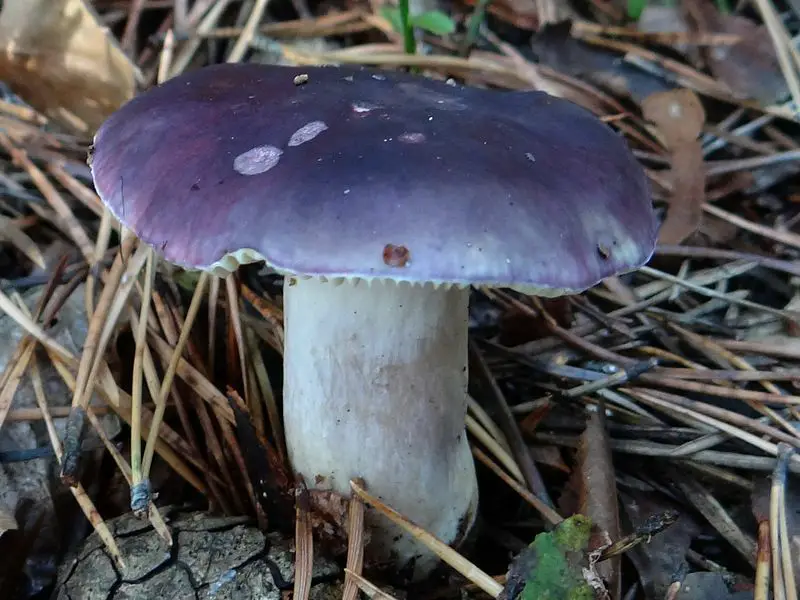
Russula sardonia, a mystical presence in the world of fungi, enthralls with its striking appearance and culinary allure.
Characteristics:
- Cap: Initially convex, later flattening, displaying amethyst blue or dark purple hues with a noticeable bluish coating.
- Plates: Frequent, branching near the stem, pure white.
- Stem: Tapering upwards, initially velvety-pubescent like the cap, then spongy and white.
- Flesh: Strong, becoming brittle, white, with a sweetish taste.
- Spore Powder: White.
Habitat & Distribution:
Found in Eurasian coniferous forests, forming mycorrhiza with common spruce.
Culinary Delights:
Considered edible with a pleasant, non-bitter taste, Russula sardonia offers culinary exploration amidst the forest bounty.
Check detailed guide on Armillaria mellea Edible Mushroom.
Russula delica
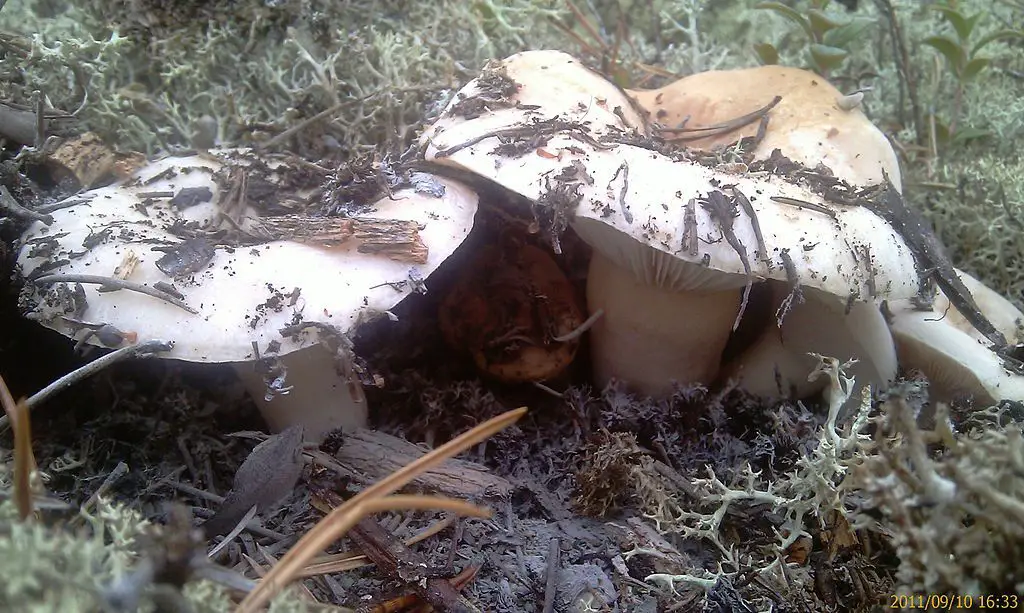
Russula delica, a graceful presence in the forest, showcases delicate features and subtle hues.
Characteristics:
- Cap: Initially convex, later funnel-shaped, with whitish surface and occasional dark zones, prone to cracking in dry conditions.
- Plates: Usually frequent, cream-colored, indistinctly bluish near the stalk, sometimes with brownish spots in maturity.
- Stem: Very strong, white with irregular brownish spots, often bluish towards the upper part.
- Flesh: Strong, white, with a sharp taste reminiscent of some Milky species.
- Spore Powder: White or light cream.
Edibility:
While edible, Russula delica offers a rather bland taste, suitable for culinary experimentation with proper preparation.
Russula mustelina (Weasel Russula)
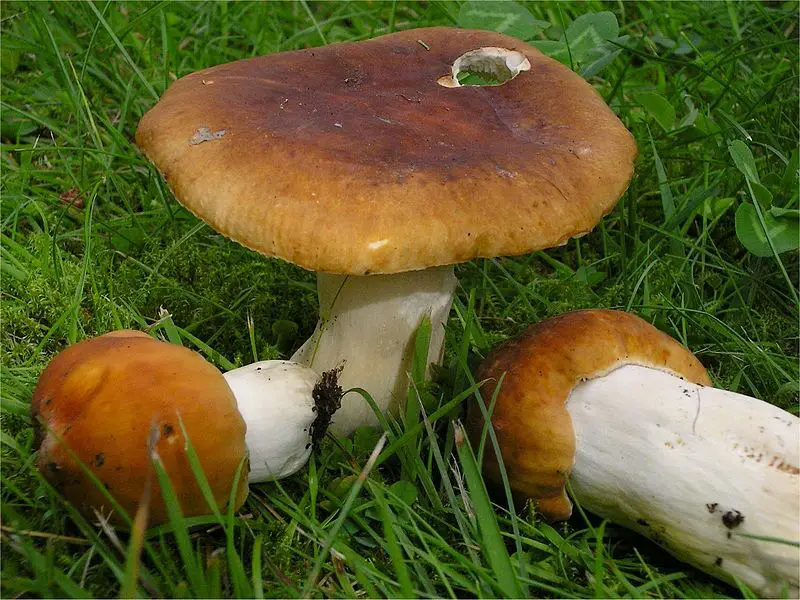
Russula mustelina, commonly known as the Weasel Russula, stands tall with its robust structure and earthy hues.
Characteristics:
- Cap: Initially hemispherical, later convex, with ocher-brown coloring and occasional wine-red zones, featuring a thick skin.
- Plates: Frequent, branching at the stem, cream-colored with rusty-brown spots in maturity.
- Stem: Cylindrical or obverse-conical, very strong, turning slightly brown with age, characterized by cavities.
- Flesh: Strong, white, turning yellow or brown with age, with a sweetish taste and cheesy smell in dry weather.
- Spore Powder: Light cream.
Habitat & Distribution:
Widely distributed in mountain coniferous forests of Eurasia and North America, forming mycorrhiza primarily with spruce.
Edibility:
Considered edible, Russula mustelina offers a strong mushroom flavor with a pleasant taste, making it a prized find for foragers.
Similar species:
- Sometimes smooth-skinned russula looks like a valui, but it has an unpleasant odor, pungent taste and a hat with a ribbed edge.
Russula fellea
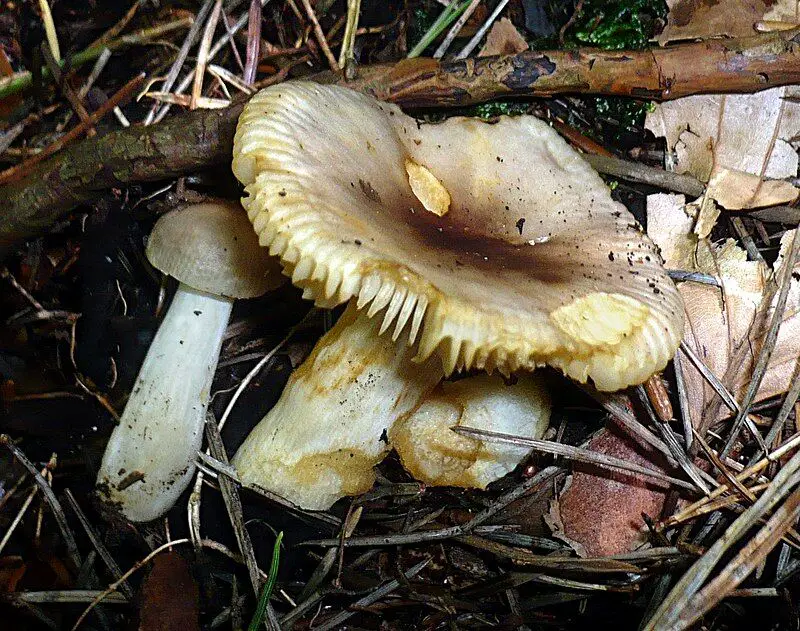
Russula fellea, known for its distinct features, adds a splash of color to forest floors.
Characteristics:
- Cap: Thinly fleshy, initially convex, later flattened and depressed, with a furrowed edge, colored in dark purple or brick red tones, turning paler with age.
- Plates: Quite frequent, branching near the stem, adherent, starting white and turning light cream.
- Stalk: Usually cylindrical or fusiform, becoming spongy and hollow, strongly yellowing when damaged.
- Flesh: Very brittle, white, turning yellow in the air, with a sweetish taste.
Edibility & Spore Powder:
Considered edible, Russula fellea produces a cream-colored spore powder.
Distribution & Habitat:
Widely distributed across Eurasia, forming mycorrhiza with both coniferous and deciduous trees. Commonly found under spruce, pine, fir, beech, and oak.
Similar species:
- Russula elegans Bres., 1882 grows under poplar, turns yellow slightly.
- Russula nitida (Pers.) Fr., 1838 grows under a birch, almost does not turn yellow when damaged, well defined by a noticeably radially furrowed edge.
- Russula odorata Romagn., 1950 grows in the oak forests of the Mediterranean, more fleshy, with a strong fruity smell.
- Russula puellula Ebbesen, FHMøller & Jul.Schäff., 1937 grows under beech, does not turn yellow.
- Russula versicolor Jul.Schäff., 1931 is the closest species, also turning yellow when damaged, growing under birch and alder.
Russula Purple Brittlegill
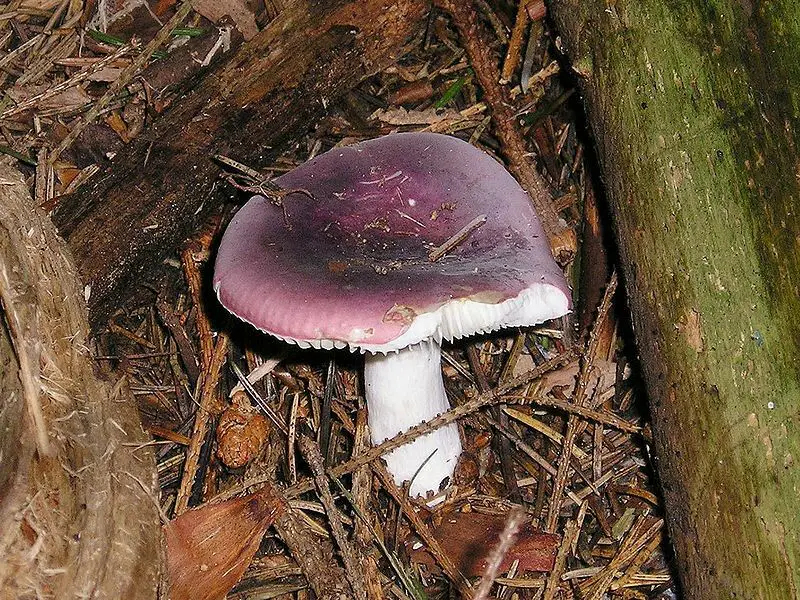
Russula Purple Brittlegill, with its mesmerizing hues, graces pine forests across Europe.
Characteristics:
- Cap: Initially convex, later flattened and depressed, showcasing lilac, dark purple, gray-violet, or purple-brown hues. Skin is shiny and slimy, peeling off partially.
- Plates: Initially quite frequent, then diverging, adhering to the stem,transitioning from cream to ocher.
- Stem: Cylindrical or club-shaped, predominantly white, occasionally pinkish or yellowish in wet weather.
- Flesh: Strong, white, turning yellowish with lilac undertones under the skin. Sweetish taste with a strong iodoform smell, especially at the stem’s base.
- Spore Powder: Ocher.
Edibility:
Considered edible, Russula Purple Brittlegill offers a pleasant, non-bitter taste, inviting culinary exploration.
Distribution & Habitat:
Widely distributed in European pine forests, Russula Purple Brittlegill can also form mycorrhiza with spruce and fir, enriching forest ecosystems.
Russula xerampelina
Russula xerampelina, commonly known as the Brown Russula, offers a feast for the senses with its distinctive features.
Characteristics:
- Cap: Initially convex, later flattened and funnel-shaped, displaying purple-red edges and purple-black centers, occasionally with brownish spots. Matte skin, sometimes velvety when dry.
- Plates: Adhering to the stem, ranging from cream to light ocher.
- Stem: Cylindrical or club-shaped, with a carmine-red tint, turning brown upon damage.
- Flesh: Strong and white, turning brown or yellow in the air. Fresh mushrooms have a weak smell, intensifying into a strong shrimp aroma when dried.
- Spore Powder: Ocher or light yellow.
Edibility:
Considered edible, Russula xerampelina boasts a pleasant, non-bitter taste, although it carries a strong specific smell.
Distribution & Habitat:
Widely distributed in both mountainous and lowland coniferous forests of Eurasia, forming mycorrhiza primarily with pine and spruce.
List with picture and names of Mushrooms that Grow in Autumn.
Lactarius lignyotus
Lactarius lignyotus, a rare gem of the forest, presents a captivating array of features and nuances.
Characteristics:
- Cap: Initially convex with a blunt tubercle, later prostrate and funnel-shaped, velvety and wrinkled in chestnut to black-brown hues.
- Plates: Frequent, wide, initially white then yellowish, turning red when pressed.
- Spore Powder: Ocher-yellow with rounded, ornamented spores.
- Leg: Cylindrical, often curved, velvety, matching cap’s color or lighter.
- Flesh: Firm, initially white then ocher-yellow, with non-caustic milky juice turning yellow then red in the air.
Habitat & Distribution:
Found in coniferous forests, particularly spruce-dominated, in mountainous regions on acidic, marshy soils. Fruits in small groups or singly.
Edibility & Usage:
Considered conditionally edible, Lactarius lignyotus is primarily used salted. Only the caps are consumed due to the hardness of the stems.
Season: mid-August – end of September (massively in the first ten days of September).
Similar species:
- Brownish milkweed (Lactarius fuliginosus) is usually lighter in color, with a light stem, grows in deciduous forests.
- Resinous black milky (Lactarius picinus), also growing under spruce trees, has a burning-acrid milky juice (the taste is not immediately felt) and a smooth, lighter leg.
Lactarius trivialis
Lactarius trivialis, a common sight in the forests of Eurasia, enchants with its vibrant hues and distinctive features.
Characteristics:
- Cap: Fleshy, initially hemispherical or convex, later flattened and depressed, often irregular in shape and mucous. Color varies from purple-lilac to pale-brown in youth, turning yellowish-lilac or pinkish-brown with age.
- Plates: Descending to the stem, frequent, whitish in youth, turning fawn as they age and gray-green when damaged by the milky juice.
- Leg: Smooth, cylindrical, hollow with age, matching cap’s color with a yellowish tinge.
- Flesh: White and firm, becoming friable, with a burning white milky juice turning olive brown when dry.
Distribution & Habitat:
Widely distributed throughout Eurasia, Lactarius trivialis thrives in both coniferous and deciduous forests, forming mycorrhiza primarily with pine, spruce, and birch.
Similar species:
- Lactarius hysginus (Fr.) Fr., 1838 – meat-red milky – is distinguished by a dark orange-brown color of the cap, a strong specific smell, as well as more pronounced spots on the stem.
- Lactarius flexuosus (Pers.) Gray, 1821 – Serushka – differs in a less slimy cap, rarer plates, and also a cottony content of the leg.
Lactarius scrobiculatus
Lactarius scrobiculatus, a majestic presence in forested landscapes, offers a mix of beauty and complexity.
Characteristics:
- Cap: Remarkably large and fleshy, initially convex, later flattening and developing a funnel shape, adorned with reddish scales and concentric zones. Mucous or sticky skin turns golden or dirty yellow, slightly browning when pressed.
- Pulp: Dense and brittle, white with a fruity smell and pungent taste, turning yellow when cut, secreting rich milky juice that turns grayish-yellow.
- Leg: Strong, whitish, densely dotted with bright yellow pits, sticky on the outside and hollow within.
- Plates: Frequent, slightly descending along the stem, acquiring red-brown spots over time.
- Spore Powder: Creamy white or light ocher, with elliptical spores.
Distribution & Habitat:
Found in coniferous (spruce and fir-spruce) and birch forests, forming mycorrhiza with conifers and birch, often in mountainous regions.
Edibility & Usage:
Considered conditionally edible in some regions, prized for pickles and marinades, bitterness removed through pre-boiling or soaking. In the West, it’s often considered inedible due to its bitter taste.
Season July – October.
Similar species:
- Real milk mushroom (Lactarius resimus) – an edible mushroom of a lighter color and without pits on the stem
- Purple milk mushroom (Lactarius repraesentaneus) with lilac milky juice, considered inedible by Western researchers
- Fringed mushroom (Lactarius citriolens) – has no dents on the stem and grows in deciduous forests
Lactarius mellow
Lactarius mellow, with its delicate features, adds a touch of elegance to forest floors.
Characteristics:
- Cap: Initially convex, later funnel-shaped with a small tubercle, thin and velvety, apricot-colored, without concentric zones.
- Plates: Adherent or descending, thin, cream-colored with occasional reddish spots.
- Spore Powder: Creamy pink with ornamented, amyloid spores.
- Leg: Cylindrical and dense, later hollow, matching cap’s color but lighter towards the top.
- Pulp: Dense and orange, pale yellow or pale orange under the skin, with minimal odor.
- Milky Juice: White, watery, non-caustic, unchanged upon exposure to air.
- Plate Evolution: Yellowish plates transition to bright ocher with age.
Distribution & Habitat:
Found in association with birch, occasionally oak and spruce, often in moss and litter, occurring singly or in small groups. Seasonally abundant from mid-July to October, peaking in August and September.
Edibility & Usage:
Considered conditionally edible, Lactarius mellow is of low quality and primarily used salted or pickled. It’s often deemed inedible in Europe.
Similar species:
- Brownish milkweed (Lactarius fuliginosus), from which it differs in a darker color of the cap and stem, thin flesh, long stem and place of growth.
- Lactarius fulvissimus is larger, reddish-orange, with a sharp unpleasant odor
Lactarius repraesentaneus
Lactarius repraesentaneus, a distinctive presence in damp forest environments, captivates with its vibrant appearance and unique characteristics.
Characteristics:
- Cap: Initially convex, later prostrate to funnel-shaped, with a curled, pubescent edge, scaly, and sticky when wet, boasting a yellow hue.
- Plates: Slightly decurrent, narrow, sometimes branched, pale yellow.
- Spore Powder: Yellowish.
- Stem: Narrowed towards the base, sticky in wet weather, becoming hollow with age, lighter than the cap with darker depressions and spots.
- Pulp: Dense and yellowish, with a mushroom smell and slight bitter taste.
- Milky Juice: Plentiful and white, turning purple rapidly upon exposure to air. All parts of the fungus swiftly change to purple when damaged.
Distribution & Habitat:
Found in mixed and deciduous forests, particularly in damp areas, forming mycorrhiza with spruce, birch, and willow. Occurs singly or in groups, primarily in the late summer to early autumn months.
Edibility & Usage:
Considered conditionally edible, Lactarius repraesentaneus is used salty.
Similar species:
- Lactarius scrobiculatus (Yellow breast) turns yellow when cut, not purple.
Tips for spruce trees mushroom Identification and Foraging
When venturing into the forest to forage for mushrooms under spruce trees, keep the following tips in mind:
- Know Your Species: Familiarize yourself with the characteristics of each mushroom species to avoid misidentification and ensure a safe foraging experience.
- Observe the Environment: Pay attention to the habitat, as certain mushrooms prefer specific conditions and tree species for growth.
- Handle with Care: Handle mushrooms with care, especially when collecting specimens for identification. Use a knife to cut mushrooms at the base of the stem, leaving the mycelium intact.
Conclusion
Mushrooms that grow under spruce trees are a valuable resource for mushroom hunters. They are easy to identify and can be found in many parts of the country. Although they are not as well known as some other types of mushrooms, they are definitely worth hunting for.
